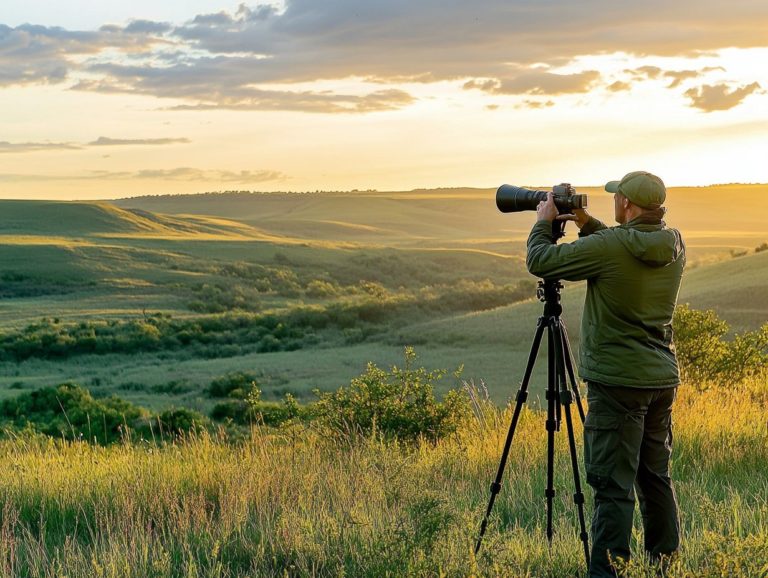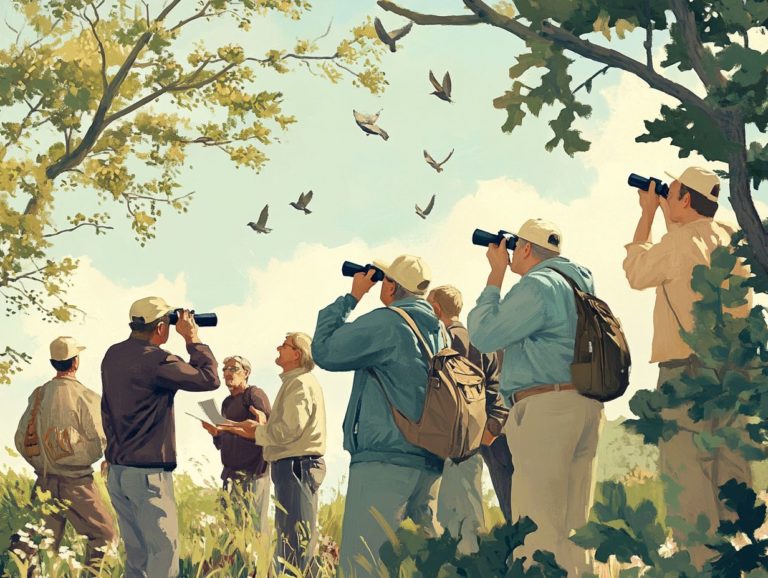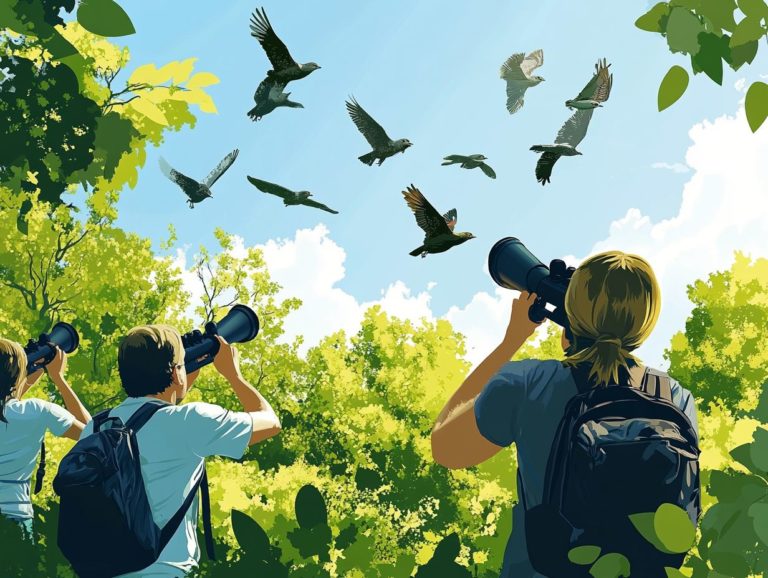Understanding Spotting Scopes: A Beginner’s Guide
Spotting scopes are essential tools for nature lovers and birdwatchers. They let you observe distant subjects clearly.
This guide explains what a spotting scope is and explores the different types available. You’ll find tips on choosing the right one for your needs.
We also include setup techniques and maintenance tips to keep your equipment in top shape.
Whether you’re starting out or looking to improve your skills, this guide has valuable information for everyone.
Contents
- Key Takeaways:
- What is a Spotting Scope?
- Types of Spotting Scopes
- Choosing the Right Spotting Scope
- Using a Spotting Scope
- Maintenance and Care
- Frequently Asked Questions
- What is a spotting scope?
- What are the main components of a spotting scope?
- Do I need a spotting scope if I already have binoculars?
- How do I choose the right magnification for my spotting scope?
- What is the difference between angled and straight spotting scopes?
- Do I need to purchase additional accessories for my spotting scope?
Key Takeaways:

- A spotting scope is a portable and powerful device for observing distant objects.
- Different types of spotting scopes have unique designs and features.
- When selecting a spotting scope, consider magnification, lens quality, and durability.
What is a Spotting Scope?
A spotting scope is an optical device designed for observing distant subjects, ideal for bird watching, wildlife sightings, and hunting.
It offers better magnification and optical quality than regular binoculars, allowing you to see details clearly.
Definition and Uses
This versatile tool provides stunning detail for birdwatching and spotting wildlife. With options from 15x to 60x magnification, you can choose the right zoom for your activity.
High-quality spotting scopes enhance your experience, letting you appreciate every detail, from feather patterns to animal movements.
Types of Spotting Scopes
Spotting scopes come in various types, each designed with unique features for birdwatching, wildlife observation, or target shooting.
The main designs include straight and angled models, impacting ease of use and stability on a tripod.
Different Designs and Features

Various designs and features of spotting scopes improve functionality. Choose between straight and angled models based on your comfort and environment.
Straight scopes are great for tracking moving subjects, while angled scopes provide a comfortable viewing angle on a tripod.
Eyepiece zoom options add versatility, allowing quick focus adjustments. Plus, waterproof features make these scopes reliable in any weather!
Get ready to explore the great outdoors with your new spotting scope!
Choosing the Right Spotting Scope
Choose the right spotting scope to unlock endless adventures in nature! When selecting the perfect scope, consider several key factors to ensure it aligns with your needs, whether for bird watching, wildlife observation, or target shooting.
Start with optical quality, as it significantly impacts the clarity and brightness of your images. Don’t overlook eye relief for your comfort during extended use. The ability to achieve close focus is also vital for observing nearby subjects.
Additionally, keep in mind the weight and design of the scope. These elements will influence portability, especially if you plan on using a tripod.
Factors to Consider
When selecting a spotting scope, you should prioritize several key factors, including optical quality, magnification range, and the type of tripod that will provide the stability you need.
Understanding these elements can profoundly elevate your viewing experience. Optical quality is paramount; it dictates how clearly and accurately you can observe distant subjects, whether you’re birdwatching or surveying expansive landscapes.
A high-quality lens minimizes distortion and enhances color fidelity, allowing for sharper images even in varying light conditions. The magnification range is also crucial, as it determines the level of detail you can see, tailored to your specific needs whether identifying distant wildlife or evaluating terrain features.
Don’t forget the importance of a sturdy tripod. A stable setup sharpens your observations and ensures comfort during those extended viewing sessions, making it an essential aspect of your selection process.
Using a Spotting Scope
To effectively utilize a spotting scope, master the setup and techniques that unlock its full potential for activities like bird watching, wildlife observation, and target shooting. The initial setup is crucial; begin by securely mounting the scope on a tripod to stabilize it and reduce vibrations.
Once positioned, familiarize yourself with adjusting the magnification and focus settings for the clearest view. You can also enhance your experience with digiscoping capturing stunning images through the scope by attaching your camera to it.
Be mindful of atmospheric conditions to elevate your results, ensuring you make the most of your observations.
Proper Setup and Techniques

Proper setup and techniques are essential for maximizing the performance of your spotting scope, particularly during bird watching and wildlife observation.
A well-installed tripod serves as the foundation for stable viewing, enhancing clarity and minimizing shake. Start by extending the tripod legs evenly to ensure a solid stance, then tighten each section for stability.
Once the scope is attached, adjust the height to align with your eye level for comfortable viewing. Begin with a lower magnification setting to easily locate your subject before zooming in for that detailed view.
Employ smooth panning techniques to track moving wildlife seamlessly. Don t forget keeping the lens clean and using a protective cover can significantly elevate your user experience and improve overall image quality.
Maintenance and Care
Proper maintenance and care of your spotting scope are essential for ensuring its longevity and optimal performance during bird watching, wildlife observation, and target shooting.
Regularly cleaning the lens is paramount; dirt and smudges can dramatically affect optical quality and clarity. Store the scope in a protective case to safeguard it against environmental factors.
It’s wise to periodically check for any signs of wear on seals and moving parts to ensure it remains waterproof and fully functional. By implementing these best practices, you ll enjoy a consistently high-quality viewing experience.
Get ready to spot your first bird with confidence!
Tips for Keeping Your Spotting Scope in Top Condition
To keep your spotting scope in excellent condition, following specific care tips enhances its durability and performance.
These tips are particularly important for activities like bird watching and wildlife observation. One crucial aspect to consider is lens quality. Clean and well-maintained lenses ensure optimal image clarity.
Regular inspections are vital. Checking for signs of wear, scratches, or moisture buildup can prevent long-term damage.
When not in use, proper storage in a padded case protects your scope from dust and impacts. Opting for a waterproof model can safeguard against unexpected weather conditions. Remember to wipe down the exterior with a soft, damp cloth after exposure to moisture.
These practices lead to a reliable and enjoyable viewing experience. Protect your scope today!
Frequently Asked Questions
What is a spotting scope?

A spotting scope is a portable telescope designed for terrestrial observation, typically used for bird watching, target shooting, and nature observation.
What are the main components of a spotting scope?
- Eyepiece
- Objective lens
- Body/housing
- Tripod mount
- Additional features such as eyepiece zoom and angled or straight eyepieces
Do I need a spotting scope if I already have binoculars?
While binoculars are great for general observation and are more portable, spotting scopes provide higher magnification and better clarity of images for specific activities like wildlife observation or target shooting. If you’re looking for detailed and long-range views, a spotting scope may be a better option.
How do I choose the right magnification for my spotting scope?
The right magnification depends on your intended use. Higher magnification gives you a closer and more detailed view but decreases the field of view. For activities like wildlife viewing, a lower magnification (around 20x) may be more suitable, while for target shooting, a higher magnification (around 60x) may be better.
What is the difference between angled and straight spotting scopes?
Angled spotting scopes have the eyepiece at a 45-degree angle from the body, while straight scopes have the eyepiece in line with the body. Angled scopes are more comfortable for extended viewing periods and allow for easier sharing. Straight scopes are more compact and better for viewing objects at or below eye level, making them ideal for hunting.
Do I need to purchase additional accessories for my spotting scope?
Some essential accessories for spotting scopes include:
- Tripod
- Carrying case
- Lens covers
- Digiscoping equipment
- Digiscoping adapter
- Sunshade
- Different eyepieces for varying magnification levels
- Camera adapters for digiscoping






